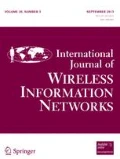Abstract
The emerging generation of personal communications satellites, built to communicate with handheld telephone units, will generate power flux on earth that is orders of magnitude higher than that of the present satellite service, and its potential interference with terrestrial-based systems is of concern. It is proposed here that the flux scattered from the ground surface into the antenna main beam and near sidelobes may cause higher interference than direct coupling into the antenna. This mechanism, previously observed in terrestrial systems, may not be mitigated by adaptive nulling techniques, and is less angle-dependent. A simple model is developed, to be used as a computational tool for assessing the interference and its functional dependence on governing parameters. In the absence of proper terrain scattering models, examples are evaluated by borrowing results from interference observed in terrestrial microwave links, which indicate the possible severity of the effect.
Similar content being viewed by others
References
J. Shapira, Terrain Scattered Interference between Microwave Links and Mobile Satellite Systems,ICT'96 Conference Record, pp. 365–368, Istanbul, Turkey, 1996.
CCIR report 1054, Interference in ratio relay systems caused by terrain scattering.
J. Shapira, TERSCAT—A Model for Prediciton of Terrain Scattered Interference in Microwave Communication,Record of the 16th Conference on Electrical & Electronics Engineers in Israel, 2.2.4, Tel-Aviv, 1989.
J. Shapira, Characteristics of surface scatter interference in terrestrial communication,Proceedings (Abstracts) of URSI 23rd General Assembly, p. 577, Prague, 1990.
A. J. Giger and J. Shapira, Interference caused by ground scattering in terrestrial microwave radio systems,Proceedings of ICC 83, pp. 1254–1261, 1983.
A. J. Giger, G. D. Alley, P. L. Sullivan, and D. E. Major, Recent advances in microwave interference prediction,Proceedings of ICC'87, 23.2.
V. K. Prabhu, A simple upper bound on microwave terrestrial interference due to terrain scatter,Proceedings of GLOBECOM'88, 33.2.1.
T. Maeyama, F. Ikegami, and Y. Kitano, Analysis of mountainreflected signal strength in digital mobile radio communications,IEICE TRANS. COMMUN., Vol. E76-B, No. 2, pp 98–102, 1993.
M. Danielsen, J. Thomsen, and M. P. Jacobsen, Mobile telephone with 100 percentage of the mountainous Faroe Islands,6th World Telecom Forum, Tech. Symp., Pro 2∥, pp. 219–225, Geneva, 1991.
M. W. Long,Radar reflectivity of land and sea, Lexington 1975.
P. Beckman and A. Spizzichino,The scattering of EM waves from rough surfaces, Pergamon, 1963.
W. C. Y. Lee,Mobile communications design fundamentals, Howard W. Sams & Co., 1986.
Author information
Authors and Affiliations
Rights and permissions
About this article
Cite this article
Shapira, J. Interference from mobile satellite systems through terrain scattering. Int J Wireless Inf Networks 3, 173–179 (1996). https://doi.org/10.1007/BF02365827
Issue Date:
DOI: https://doi.org/10.1007/BF02365827




